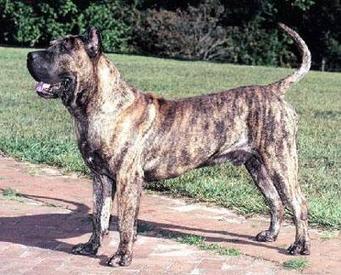
More commonly known as the Perro de Preso Canario, a breed hailing from the Canary Islands in the 1800s, the true origins and ancestry of the breed remain largely unknown. Its early forebears are thought to be English Mastiffs, Bulldogs of old and the now extinct Bardino Majero, a fighting breed native to the Islands. Primarily bred for the sporting purpose of pit fighting, the Canary Dog evolved into an able-bodied, powerful and willing fighter, with tenacity and fearlessness. Once the practice was ended in 1940, populations of the Canary Dog diminished to the point of near extinction, although the breed was resurrected by the efforts of Dr. Carl Semencic in the 1970s.
A powerful and imposing-looking breed, the Canary Dog has a muscular and robust build, with straight legs, a broad muzzle, a deep chest for enhanced lung capacity and a strong jaw. The single coat is typically short and smooth, common in colour variations of fawn and brindle, usually with white markings. Following televised cases of the Canary Dog attacking and killing its owners, the breed has established a fearsome reputation for itself, being restricted and banned in most European countries. Besides its fighting history, this versatile working breed was used in guarding, cattle wrangling and defending against wild dogs and predators.
Banned in most countries, the Canary Dog is rarely seen outside its native country, even less within the domestic setting. Intimidating in appearance, the Canary makes a great guard dog, protecting its family if potential danger is perceived. Not encouraged as a companion pet due to its powerful build and inherent tenacity, the Canary Dog requires firm leadership, early socialisation and consistent obedience training from puppyhood in order to stand it in good stead through maturity. A healthy Canary Dog will weigh an average of 35-60 kg depending on its gender, with a life expectancy of 10-12 years.
Prone to various genetic and breed-specific diseases, the Canary Dog is relatively high maintenance when it comes to caring for and supporting good health. Susceptible to optical disorders, epilepsy and ligament problems, as well as more serious incidences of gastric tortion and bloat, the Canary Dog requires regular health checks so as to maintain optimum health and prosperity.








From West Midlands, United Kingdom
Best breed I’ve owned by far! I own 2 boys and they get on so well together. Their protective of their home which is what you want in a dog. But their also great family dogs and love the kids. Their a powerful breed and they get really big & will need a lot of exercise and training so they really aren’t for everyone. But when you put the time and effort into them you get an amazing family dog.